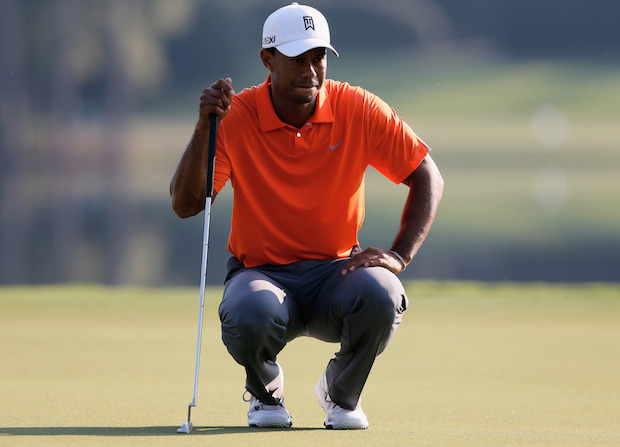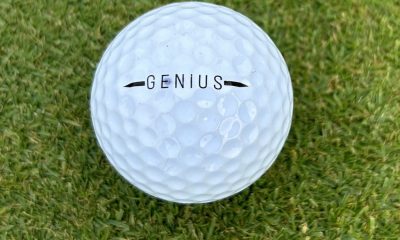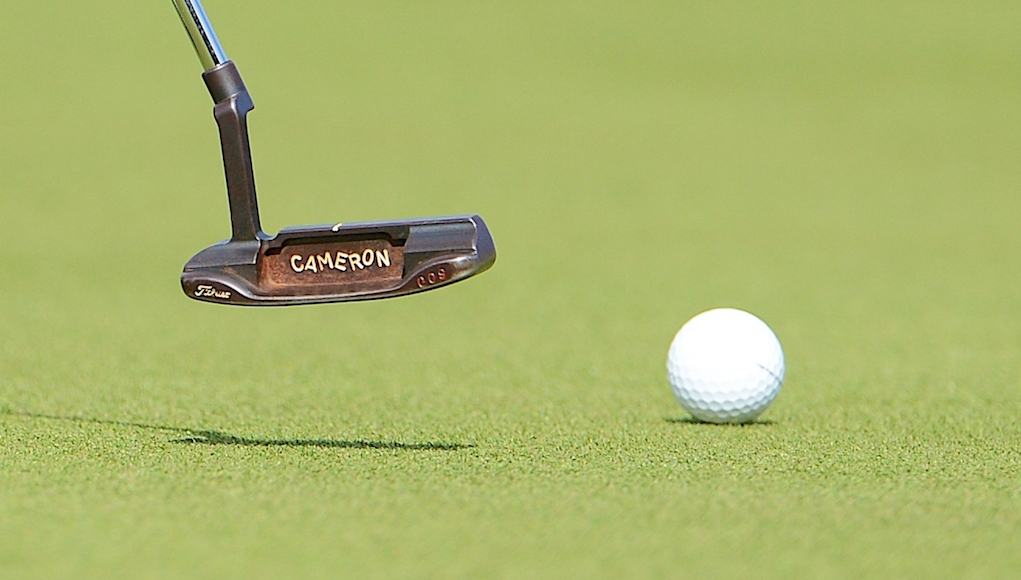Instruction
Stetina: The Ultimate Putting Program

Putting is probably the easiest part of the game, and yet so many people struggle immensely with it. You don’t have to be strong, or in any way physically gifted to be a good putter. You simply have to roll a golf ball on your intended line, as far as the hole. Francis Ouimet’s caddie, Eddie Lowery, had great advice for his player in the movie, The Greatest Game Ever Played, when he told Francis to, “Read it, roll it, and hole it.”
Now I am not sure if this is a factual quote or simply a Hollywood add-on, but nevertheless, this saying offers great simplicity as to what is truly required to putt well. Before you can trust yourself and completely let go, as Eddie Lowery suggests, there are a few things that you need to understand.
Putting comes down to finding balance to the equation that David Edel calls, “The Putting Triad,” which consists of aim, speed, and path. These variables are equal to one another, so when one of them is flawed you have to compensate with another variable for your ball to go in the hole.

Depending on your skill level and the amount that you practice, you can become partially proficient at some form of compensation. Most touring professional don’t aim correctly or have proper speed control, and yet they seem to perform just fine. But they practice endlessly, something that I doubt you do.
Putting accounts for nearly half of a golfer’s score, decides almost every match and for most golfers is undervalued in the improvement process. In this series of articles, I am going to provide insight into a putting model that will allow you to understand the three basic fundamentals of putting; aim, speed, and path. I will also clarify two types of putting strokes and two ways of reading greens. This allows me to blend science with art and offer the ultimate putting program, so that when you’re on the golf course all you have to do is, “Read it, roll it, and hole it.”
To Continue With The Ultimate Putting Program:
Instruction
The Wedge Guy: Beating the yips into submission

There may be no more painful affliction in golf than the “yips” – those uncontrollable and maddening little nervous twitches that prevent you from making a decent stroke on short putts. If you’ve never had them, consider yourself very fortunate (or possibly just very young). But I can assure you that when your most treacherous and feared golf shot is not the 195 yard approach over water with a quartering headwind…not the extra tight fairway with water left and sand right…not the soft bunker shot to a downhill pin with water on the other side…No, when your most feared shot is the remaining 2- 4-foot putt after hitting a great approach, recovery or lag putt, it makes the game almost painful.
And I’ve been fighting the yips (again) for a while now. It’s a recurring nightmare that has haunted me most of my adult life. I even had the yips when I was in my 20s, but I’ve beat them into submission off and on most of my adult life. But just recently, that nasty virus came to life once again. My lag putting has been very good, but when I get over one of those “you should make this” length putts, the entire nervous system seems to go haywire. I make great practice strokes, and then the most pitiful short-stroke or jab at the ball you can imagine. Sheesh.
But I’m a traditionalist, and do not look toward the long putter, belly putter, cross-hand, claw or other variation as the solution. My approach is to beat those damn yips into submission some other way. Here’s what I’m doing that is working pretty well, and I offer it to all of you who might have a similar affliction on the greens.
When you are over a short putt, forget the practice strokes…you want your natural eye-hand coordination to be unhindered by mechanics. Address your putt and take a good look at the hole, and back to the putter to ensure good alignment. Lighten your right hand grip on the putter and make sure that only the fingertips are in contact with the grip, to prevent you from getting to tight.
Then, take a long, long look at the hole to fill your entire mind and senses with the target. When you bring your head/eyes back to the ball, try to make a smooth, immediate move right into your backstroke — not even a second pause — and then let your hands and putter track right back together right back to where you were looking — the HOLE! Seeing the putter make contact with the ball, preferably even the forward edge of the ball – the side near the hole.
For me, this is working, but I am asking all of you to chime in with your own “home remedies” for the most aggravating and senseless of all golf maladies. It never hurts to have more to fall back on!
Instruction
Looking for a good golf instructor? Use this checklist

Over the last couple of decades, golf has become much more science-based. We measure swing speed, smash factor, angle of attack, strokes gained, and many other metrics that can really help golfers improve. But I often wonder if the advancement of golf’s “hard” sciences comes at the expense of the “soft” sciences.
Take, for example, golf instruction. Good golf instruction requires understanding swing mechanics and ball flight. But let’s take that as a given for PGA instructors. The other factors that make an instructor effective can be evaluated by social science, rather than launch monitors.
If you are a recreational golfer looking for a golf instructor, here are my top three points to consider.
1. Cultural mindset
What is “cultural mindset? To social scientists, it means whether a culture of genius or a culture of learning exists. In a golf instruction context, that may mean whether the teacher communicates a message that golf ability is something innate (you either have it or you don’t), or whether golf ability is something that can be learned. You want the latter!
It may sound obvious to suggest that you find a golf instructor who thinks you can improve, but my research suggests that it isn’t a given. In a large sample study of golf instructors, I found that when it came to recreational golfers, there was a wide range of belief systems. Some instructors strongly believed recreational golfers could improve through lessons. while others strongly believed they could not. And those beliefs manifested in the instructor’s feedback given to a student and the culture created for players.
2. Coping and self-modeling can beat role-modeling
Swing analysis technology is often preloaded with swings of PGA and LPGA Tour players. The swings of elite players are intended to be used for comparative purposes with golfers taking lessons. What social science tells us is that for novice and non-expert golfers, comparing swings to tour professionals can have the opposite effect of that intended. If you fit into the novice or non-expert category of golfer, you will learn more and be more motivated to change if you see yourself making a ‘better’ swing (self-modeling) or seeing your swing compared to a similar other (a coping model). Stay away from instructors who want to compare your swing with that of a tour player.
3. Learning theory basics
It is not a sexy selling point, but learning is a process, and that process is incremental – particularly for recreational adult players. Social science helps us understand this element of golf instruction. A good instructor will take learning slowly. He or she will give you just about enough information that challenges you, but is still manageable. The artful instructor will take time to decide what that one or two learning points are before jumping in to make full-scale swing changes. If the instructor moves too fast, you will probably leave the lesson with an arm’s length of swing thoughts and not really know which to focus on.
As an instructor, I develop a priority list of changes I want to make in a player’s technique. We then patiently and gradually work through that list. Beware of instructors who give you more than you can chew.
So if you are in the market for golf instruction, I encourage you to look beyond the X’s and O’s to find the right match!
Instruction
What Lottie Woad’s stunning debut win teaches every golfer

Most pros take months, even years, to win their first tournament. Lottie Woad needed exactly four days.
The 21-year-old from Surrey shot 21-under 267 at Dundonald Links to win the ISPS Handa Women’s Scottish Open by three shots — in her very first event as a professional. She’s only the third player in LPGA history to accomplish this feat, joining Rose Zhang (2023) and Beverly Hanson (1951).
But here’s what caught my attention as a coach: Woad didn’t win through miraculous putting or bombing 300-yard drives. She won through relentless precision and unshakeable composure. After watching her performance unfold, I’m convinced every golfer — from weekend warriors to scratch players — can steal pages from her playbook.
Precision Beats Power (And It’s Not Even Close)
Forget the driving contests. Woad proved that finding greens matters more than finding distance.
What Woad did:
• Hit it straight, hit it solid, give yourself chances
• Aimed for the fat parts of greens instead of chasing pins
• Let her putting do the talking after hitting safe targets
• As she said, “Everyone was chasing me today, and managed to maintain the lead and played really nicely down the stretch and hit a lot of good shots”
Why most golfers mess this up:
• They see a pin tucked behind a bunker and grab one more club to “go right at it”
• Distance becomes more important than accuracy
• They try to be heroic instead of smart
ACTION ITEM: For your next 10 rounds, aim for the center of every green regardless of pin position. Track your greens in regulation and watch your scores drop before your swing changes.
The Putter That Stayed Cool Under Fire
Woad started the final round two shots clear and immediately applied pressure with birdies at the 2nd and 3rd holes. When South Korea’s Hyo Joo Kim mounted a charge and reached 20-under with a birdie at the 14th, Woad didn’t panic.
How she responded to pressure:
• Fired back with consecutive birdies at the 13th and 14th
• Watched Kim stumble with back-to-back bogeys
• Capped it with her fifth birdie of the day at the par-5 18th
• Stayed patient when others pressed, pressed when others cracked
What amateurs do wrong:
• Get conservative when they should be aggressive
• Try to force magic when steady play would win
• Panic when someone else makes a move
ACTION ITEM: Practice your 3-6 foot putts for 15 minutes after every range session. Woad’s putting wasn’t spectacular—it was reliable. Make the putts you should make.
Course Management 101: Play Your Game, Not the Course’s Game
Woad admitted she couldn’t see many scoreboards during the final round, but it didn’t matter. She stuck to her game plan regardless of what others were doing.
Her mental approach:
• Focused on her process, not the competition
• Drew on past pressure situations (Augusta National Women’s Amateur win)
• As she said, “That was the biggest tournament I played in at the time and was kind of my big win. So definitely felt the pressure of it more there, and I felt like all those experiences helped me with this”
Her physical execution:
• 270-yard drives (nothing flashy)
• Methodical iron play
• Steady putting
• Everything effective, nothing spectacular
ACTION ITEM: Create a yardage book for your home course. Know your distances to every pin, every hazard, every landing area. Stick to your plan no matter what your playing partners are doing.
Mental Toughness Isn’t Born, It’s Built
The most impressive part of Woad’s win? She genuinely didn’t expect it: “I definitely wasn’t expecting to win my first event as a pro, but I knew I was playing well, and I was hoping to contend.”
Her winning mindset:
• Didn’t put winning pressure on herself
• Focused on playing well and contending
• Made winning a byproduct of a good process
• Built confidence through recent experiences:
- Won the Women’s Irish Open as an amateur
- Missed a playoff by one shot at the Evian Championship
- Each experience prepared her for the next
What this means for you:
• Stop trying to shoot career rounds every time you tee up
• Focus on executing your pre-shot routine
• Commit to every shot
• Stay present in the moment
ACTION ITEM: Before each round, set process goals instead of score goals. Example: “I will take three practice swings before every shot” or “I will pick a specific target for every shot.” Let your score be the result, not the focus.
The Real Lesson
Woad collected $300,000 for her first professional victory, but the real prize was proving that fundamentals still work at golf’s highest level. She didn’t reinvent the game — she simply executed the basics better than everyone else that week.
The fundamentals that won:
• Hit more fairways
• Find more greens
• Make the putts you should make
• Stay patient under pressure
That’s something every golfer can do, regardless of handicap. Lottie Woad just showed us it’s still the winning formula.
FINAL ACTION ITEM: Pick one of the four action items above and commit to it for the next month. Master one fundamental before moving to the next. That’s how champions are built.
PGA Professional Brendon Elliott is an award-winning coach and golf writer. You can check out his writing work and learn more about him by visiting BEAGOLFER.golf and OneMoreRollGolf.com. Also, check out “The Starter” on RG.org each Monday.
Editor’s note: Brendon shares his nearly 30 years of experience in the game with GolfWRX readers through his ongoing tip series. He looks forward to providing valuable insights and advice to help golfers improve their game. Stay tuned for more Tips!























Matt
Dec 3, 2013 at 12:48 pm
I am sure when people examine this, they think of 8, 10, or 12ft putts. However, I have recently taken notice of how important this concept is in the 3ft side hill putt. Your playing partners, trying to help, would say it breaks about 6in, but they don’t know how hard I am going to hit. I prefer to drop the ball in the top of the cup with little speed as opposed to slamming into the back. I just hate being further away if I miss than the original putt. Looking forward to the rest of the story.
Henry Stetina
Dec 3, 2013 at 12:58 pm
Matt,
You are correct. I see a lot of golfers hitting short putts very hard. Our studies and those of Aimpoint show that optimal speed is for it to roll one revolution (6-8″) past the hole if it were to miss. For every revolution past that you diminish the effective size of the hole by 12%. Eventually the ball will be moving so fast that gravity cannot pull the ball into the hole. I will discuss this in more detail in a few weeks. Thanks for your input.
HS
Henry Stetina
Dec 2, 2013 at 7:29 pm
Guys,
Thanks for the feedback but remember to be patient. Though you may already be knowledgeable of this information, there are others who don’t understand the relationship between Aim, Speed, and Path. There are a lot of golfers who don’t see the correlation between aiming the putter to the right and making an out-to-in stroke. The Putting Triad is the foundation to becoming a better putter and I see it as a process that we should take one step at a time. This is an introductory article giving you a basic understanding of the articles to come. The next article will give you information about putter design and how it is probably affecting your ability to aim your putter.
I hope this clarifies my intent.
Thanks,
HS
Dan
Dec 2, 2013 at 7:27 pm
On all the posts, everyone is so quick to give harch criticism. Is the comment section meant for all amateur writing critics to add their 5 cents? What happened to common courtesy and decentsy? The internet gives people the anonymity to be douches. Just sayin…
That being said, looking forward to the next article. hopefully some good insight and new perspective on putting!
Henry Stetina
Dec 2, 2013 at 7:39 pm
Thank you Dan. I use to be know-all writer behind an internet profile but I quickly learned that the world is full of great information and seeing things from different perspectives is valuable in gaining knowledge. I assure you that the next article will be very informative and probably from a different perspective than what is already mainstream in the golf industry.
HS
Mats "Pump 2"
Dec 2, 2013 at 9:46 am
Agree with you Ian! Useless introduction, telling us things we already know and why wait a week before publishing the following steps? Hmm….makes no sense to me!
Martin
Dec 2, 2013 at 7:02 am
I thought the same, why publish an article which is really just ans introduction into a series.
Ian Bainbridge
Dec 2, 2013 at 2:43 am
Why post this without any actual instruction or advice? We all know about aim speed and path, its how to do it that we fail to implement!